If you want to add a hint of tropical evergreen vibe to your home, you must pick the Philodendrons. These plants are big and leafy, adding a new flare of green to your home. They are also very easy to maintain, and people will be awed by their beautifully shaped leaves.
There has been a debate over Philodendron Xanadu vs. Selloum, as plant lovers are confused about which of these houseplants is right for them.
Is Xanadu the same as Selloum? No, they are not, even though they come from the same Araceae family.
One may be more suitable for you, and the other might not. So, if you want to find the most suitable one and know its characteristics, this is the right place! Let’s jump in!
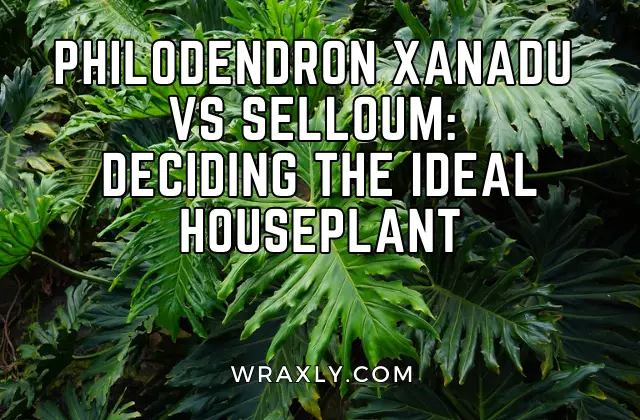
What Is Philodendron Xanadu?
Philodendron Xanadu is a plant of the Araceae family. Initially known as Winterbourne Philodendron, a somewhat ironic name given that this plant does best in temperate subtropical and tropical climates, a perennial plant native to Brazil. It was renamed Philodendron Xanadu in 1988.
Xanadu plants can be grown inside houses or outdoors. Rather than growing vertically, it tends to spread its “toothed” leaves even further and can reach 5 feet in width. However, if you keep it indoors, it won’t spread as much.
This plant is low maintenance and common in homes around the world. There are 500 philodendron species identified so far. The Golden Goddess Philodendron, the Green Dragon hybrid, and the Sweetheart Philodendron are just a few that are very popular among houseplant lovers.
Philodendron Xanadu plants from Amazon
| Imagen | Título | Principal | Comprar |
|---|---|---|---|
 | PlantBros Philodendron 'Xanadu' (PhilodendronxWinterbourn) Live Plant Indoor Exotic Houseplant | Principal | Consultar mi precio en Amazon |
Arriba | yunakesa Philodendron Xanadu Philodendron Xanadu 4” Pot | Principal | Consultar mi precio en Amazon |
 | Philodendron Plant Live - Xanadu - in 6 inch Grower Pot | Principal | Consultar mi precio en Amazon |
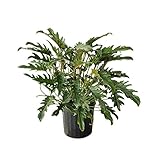 | PlantVine Philodendron 'Xanadu' - Large - 8-10 Inch Pot (3 Gallon), Live Indoor Plant | Principal | Consultar mi precio en Amazon |
 | Philodendron - 'Xanadu' | Principal | Consultar mi precio en Amazon |
 | Xanadu Cut Leaf Philodendron - Live Plant in a 4 Inch Pot - Philodendron Xanadu - Compact Easy Care Evergreen Houseplant | Principal | Consultar mi precio en Amazon |
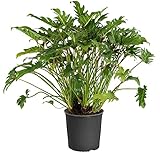 | Philodendron Xanadu | Principal | Consultar mi precio en Amazon |
What Is Philodendron Selloum?
Philodendron Selloum is a tropical plant with large, showy leaves grown as houseplants in temperate climates. It is also known as Horsehead Philodendron, Hope Philodendron, Split-Leaf Philodendron, and Buckhorn Philodendron.
The name of the plant came from Heinrich Schott. He studied the philodendron extensively and named the plant P. bipinnatifidum.
Double is “Bi,” Spring is “pinna,” and Split is “findo.” Overall, the taxonomy indicates bilaterally symmetrical plants with pinnate, branched leaves (a.k.a., a plant with beautiful tropical leaves).
This plant is native to South America and is native to the tropics, especially in Brazil, Bolivia, Argentina, and Paraguay. They grow naturally and generously in tropical rainforests.
If you want to know how to care for this plant, consider where it comes from—bright light filtered by rainforest canopy and humidity patches!
These plants belong to the Philodendron genus, meaning “lover of trees” in Greek. There are about 450 cultivars in this genus, all competently accepted by their large green leafy leaves that grow as tall as five feet.
The plant’s vast leaves are glossy and create amazing shadows due to their exclusive cutouts. They can grow very wide and cover a lot of areas.
Philodendron Selloum plants from Amazon
| Imagen | Título | Principal | Comprar |
|---|---|---|---|
 Arriba
Arriba | Philodendron Selloum by LEAL PLANTS ECUADOR | Cut Leaf Philodendron Live Plant| Philodendron Variegated Plants|Live Split-Leaf Philodendron |California Tropicals Living Plants| Hibiscus Live Plant| | Principal | Consultar mi precio en Amazon |
Arriba Arriba
Arriba | Live Philodendron Selloum 6pack Seedlings 6"-10" Tall Floral Green Gardens | Principal | Consultar mi precio en Amazon |
 Arriba
Arriba | Philodendron Selloum Seeds (Philodendron 'Hope', Split-Leaf Philodendron) Exotic Tropical Foliage Plant Seeds | Principal | Consultar mi precio en Amazon |
 | United Nursery Live Philodendron Shangri La, Indoor Outdoor House Plant, Indoor Tropical Plant, Low Maintenance Easy Care Plant, Ships Fresh from Our Farm in 10 inch Grower Pot | Principal | Consultar mi precio en Amazon |
 | Lacy Tree PHILODENDRON Split Leaf Cut-Leaf Selloum House Plant Flower jocad (15 Seeds) | Principal | Consultar mi precio en Amazon |
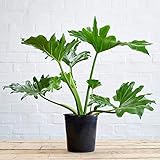 | Split-Leaf Philodendron - Live Plant in a 3 Gallon Growers Pot - Philodendron Selloum - Slow Growing Evergreen Indoor or Outdoor Houseplant | Principal | Consultar mi precio en Amazon |
What is the Difference Between Philodendron Selloum vs Philodendron Xanadu?
You may still be confused about which Philodendron plant to get because they are both magnificent. We decided to make your decision easier by creating a differentiation chart of the two plants, which will hopefully help you in your decision between Philodendron Selloum vs Philodendron Xanadu.
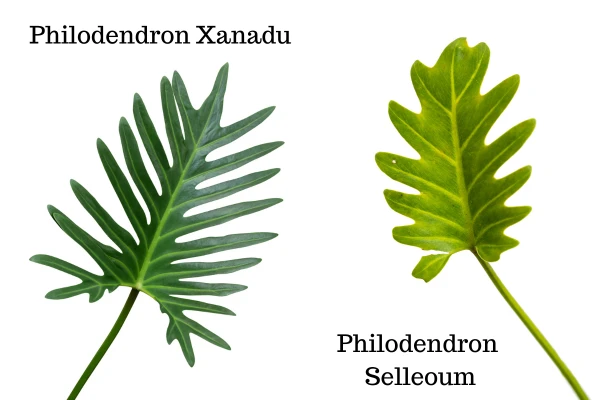
Here you will find their characteristics, traits, maintenance information, and more.
| Difference Between Philodendron Xanadu & Selloum | ||
| Philodendron Xanadu | Philodendron Selloum | |
| Width When Mature | 6 to 7 feet | 12 to 15 feet |
| Height When Mature | 5 feet | 6 to 12 feet |
| Hardiness Zone | 10-11 | 8b-11 |
| Growth Habit | Outwards | Upwards |
| Suelo | Well-Draining Mix, High Organic Matter, pH 5.6 to 7.5 | Moisture Retentive, Nutrient-Filled Soil, pH 5.0 to 6.0 |
| Luz | Indirect Medium | Indirect Bright |
| Temperatura | 65℉-85℉ (18℃-29℃) | 65℉-85℉ (18℃-29℃) |
| Frequency of Watering | Summer: Once a weekWinter: Once in 2 weeks | Summer: Once a weekWinter: Once in 2 weeks |
| Diseases | Root Rotting, Leaf Spot Disease | Bacterial Blight |
| Insects or Pests | Aphid & Mealybugs | Spider Mites |
Why Choose Philodendron Xanadu?
A shorter version of the Philodendron Selloum, Xanadu is loved for its synthesized leaves that become clumps. Novice plant owners and longtime home gardeners love it for its fantastic looks and easy-going nature. With just some primary care to make your Xanadu thrive, you can enjoy this appealing plant at home or in the office.
Moreover, being a tropical plant, Xanadu prefers moderate to bright indirect light. You can easily keep your Xanadu near a window, which will keep the plant out of direct light but still allow it to get a good amount of sunlight.
But the plant also can work as a great outdoor plant to brighten your landscape. Choose a bright, shaded area if it’s growing outdoors. Another benefit is that Philodendron Xanadu does not require pruning. You can maintain its giant mushroom cap-like shape by placing it in a well-lit area in your backyard. This will help keep it compressed and prevent the legs from looking slender.
Why Choose Philodendron Selloum?
Bright, strong light is ideal for Philodendron Selloum growth. In the rainforest, such low-growing plants are not exposed to immediate sunlight. Too much will transform the lovely green leaf color to yellow; however, adding a little light will make the plant develop a little faster.
Insufficient light results in dark green leaves, short stems, and long legs. The leaves are also small and lackluster. Place the plant by a window that faces the south or north and receives bright light but no direct sunlight. You must keep in mind, though, that it extends toward the light. So, rotate the plant occasionally to keep it from becoming crooked.
Moreover, the plants are habituated to dark, nutrient-rich, and slightly alkaline soils, making them easier to care for.
To minimize overwatering, the soil should retain moisture while draining and help prevent root rot disease. The most challenging aspect of caring for Philodendron Selloum is regando it.
Keep in mind that they are from South America, where it usually rains and is quite humid. Because of this, if this plant is not given enough water, it will wilt, shed its leaves, and maybe even perish.
Another benefit of Philodendron Selloum is that it filters out toxins like xylene and toluene and actually improves the air quality in your room. However, it is essential to note that calcium oxalate crystals are mildly toxic to humans and animals.
¿De qué estar consciente?
Philodendron Xanadu
This plant is toxic to cats and dogs. If you think your pet has ingested part of a stem, leaf, or root, be alert for obvious sicknesses such as mouth swelling or vomiting. Your pet will also start drooling more than usual.
So, if you see your pet drooling for a long time, call your local veterinarian or poison control for proper medical care.
Philodendron Selloum
Aphids, mealybugs, scales, and araña roja can cause problems in your Philodendron Selloum. If you find one of these pests, spray the entire plant with warm soapy water or pesticide.
Scrub off the limescale with a small toothbrush. Although it is not as toxic as Xanadu, keeping it away from pets and children is a good idea.
- Philodendron is probably best known from its gardening heyday in the groovy 60s and 70s. Its big bold shape and tropical overtones just seemed to fit the times. Since then, its become a bit of a landscape mainstay, particularly the newer, more compact forms. In this book, you will discover:
- Phibdendon Xanaelu Care (Thazurratophanardi)
- Philodendron Xanadu Overview
- Philodendron Xanadu Care Summary
- Philodendron Xanadu Light requirements
- How To Water Philodendron Xanadu
- And so much mo
preguntas frecuentes
Philodendron Selloum is a natural air filter. Its big leaves work as a vacuum that removes toxins and contaminants from the air, leaving us with more fresh oxygen to breathe.
Both Philodendrons look fantastic with their big, green, and soft spiky leaves. But if we had to choose, we would go for Philodendron Xanadu. Xanadu has a short trunk with aerial roots, and its leaves spread beautifully around as it ages.
The main difference in the plants lies in their leaves. Their foliage and height are a big giveaway when trying to differentiate between the two. Selloum leaves usually grow a lot bigger than Xanadu and have a darker green color. On the other hand, Xanadu looks like a lovely shrub with soft, light green color leaves.
Philodendron Selloum and Xanadu both have fast growth rates. The plants can achieve maturity at 10 years; however, they won’t reach the flowering age before 15 or 20 years.
Final Thoughts on Philodendron Xanadu vs Selloum
We hope this article settles the debate between Philodendron Xanadu Vs. Selloum. Philodendron plants can be a fantastic addition to your household and bring a peaceful tropical feeling to our atmosphere.
Now you will easily distinguish between the two when shopping for a new leafy friend. Moreover, if you ever decide to get both, we guarantee you will be able to identify them.

Darrell tiene una pasión por la jardinería que heredó de su padre. Ir aquí para leer más sobre la influencia que tuvo su padre en su amor por la jardinería. Si desea enviar un mensaje rápido a Darrell, visite su página de contacto aquí.


![Cómo regar las plantas de interior [Cuidado de las plantas 101]](https://wraxly.com/wp-content/uploads/2021/03/How-to-Water-Indoor-Plants-Plant-Care-101-1200-1024x576.webp)

![Cultivo de plantas a partir de esquejes [Una guía sencilla]](https://wraxly.com/wp-content/uploads/2021/03/Growing-Plants-from-Cuttings-A-Simple-Guide-1200-1024x576.webp)